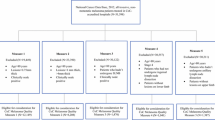Abstract
Background
Clinical practice guidelines have been developed to improve melanoma patient care. However, it is unclear whether failure to comply with these standards (either excessive or inadequate treatment) increases morbidity or relapse rates. Therefore, we undertook this study to evaluate the effect of variance from National Comprehensive Cancer Network (NCCN) recommendations on postoperative complication rates and disease recurrence.
Methods
We retrospectively reviewed our institutional cancer registry data on 327 clinically node-negative melanoma patients and assessed compliance with NCCN guidelines, complication rates, and outcome. Data were confirmed by chart, pathology report, and operative note review. Statistical analysis was performed by using the SAS statistical software package.
Results
Postoperative complications were documented in 17% of patients and were 3.4-fold higher for patients treated in a margin-noncompliant fashion and 2.4-fold higher for patients treated in a lymph-node-noncompliant manner (P < 0.001 for both). After mean follow-up of 51 months, disease recurred in 58 patients (18%) at a mean of 33 months (range 4–93 months). Locoregional disease alone as the first site of relapse was seen in 24% of margin-noncompliant versus 6% of margin-compliant cases and in 33% of lymph-node-noncompliant versus 6% of lymph-node-compliant cases (P < 0.0001).
Conclusion
While there are valid reasons for variance from treatment algorithms, these data suggest that compliance with NCCN guidelines improves outcome and decreases morbidity in clinically node-negative melanoma patients.




Similar content being viewed by others
References
Jemal A, Siegel R, Ward E, et al. Cancer Statistics, 2008. CA Cancer J Clin 2008; 58:71–96
NCCN Clinical Practice Guidelines in Oncology: Melanoma V.2.2006. Available at http://www.nccn.org [accessed November 1, 2007]
Garbe C, Hauschild A, Volkenandt M, et al. Evidence and interdisciplinary consensus-based German guidelines: surgical treatment and radiotherapy of melanoma. Melanoma Res 2008; 18:61–7
Kelly JW, Henderson MA, Thursfield VJ, et al. The management of primary cutaneous melanoma in Victoria in 1996 and 2000. Med J Aust 2007; 187:511–4
Erickson JL, Velasco J M, Hieken TJ. Compliance with melanoma treatment guidelines in a community teaching hospital: time trends and other variables. Ann Surg Oncol 2008; 15:1211–7
Bowles EJA, Tuzzio L, Wiese CJ, et al. Understanding high-quality cancer care: a summary of expert perspectives. Cancer 2008; 112:934–42
Amerling R, Winchester JF, Ronco C. Guidelines have done more harm than good. Blood Purif 2008; 26:73–6
Thomas JM, Newton-Bishop J, A’hern R, et al. Excision margins in high-risk malignant melanoma. N Engl J Med 2004; 350:757–66
Lens MB, Dawes M, Goodacre T, et al. Excision margins in the treatment of primary cutaneous melanoma: a systematic review of randomized controlled trials comparing narrow versus wide excision. Arch Surg 2002; 137:1101–6
Balch CM , Urist MM, Karakousis CP, et al. Efficacy of 2-cm surgical margins for intermediate-thickness melanomas (1 to 4 mm). Ann Surg 1993; 218:262–9
Morton DL, Cochran AJ, Thompson JF, et al. Sentinel node biopsy for early-stage melanoma: accuracy and morbidty in MSLT-I, an international multicenter trial. Ann Surg 2005; 242:302–11
Topar G, Eisendle K, Zelger B. Subcutaneous infusion anaesthesia for sentinel lymph node biopsy for melanoma: method and complications. J Plast Reconstr Aesthetic Surg 2008; 61:116–9
Kretschmer L, Thomas K-M, Peeters S, et al. Postoperative morbidity of lymph node excision for cutaneous melanoma-sentinel lymphonodectomy versus complete regional lymph node dissection. Melanoma Res 2008; 18:16–21
Collins TC, Daley J, Henderson WH, et al. Risk factors for prolonged length of stay after major elective surgery. Ann Surg 1999; 230:251–9
Law WL, Choi HK, Lee YM, et al. The impact of postoperative complications on long-term outcomes following curative resection for colorectal cancer. Ann Surg Oncol 2007; 14:2559–66
Khuri SF, Henderson WB, DePalma RG, et al. Determinants of long-term survival after major surgery and the adverse effect of postoperative complications. Ann Surg 2005; 242:326–41
McKinnon JG, Starritt EC, Scolyer RA, et al. Histopathologic excision margin affects local recurrence rate. Analysis of 2681 patients with melanomas ≤2 mm thick. Ann Surg 2005; 241:326–33
Haigh PI, DiFronzo LA, McCready DR. Optimal excision margins for primary cutaneous melanoma: a systematic review and meta-analysis. Can J Surg 2003; 46:419–26
Lens MB, Nathan P, Bataille V. Excision margins for primary cutaneous melanoma: updated pooled analysis of randomized controlled trials. Arch Surg 2007; 142:885–93
Veronesi U, Cascinelli N. Narrow excision (1-cm margin): a safe procedure for thin cutaneous melanoma. Arch Surg 1991; 126:438–41
Haniff J, deVries E, Claassen ATPM, et al. Non-compliance with the re-excision guidelines for cutaneous melanoma in The Netherlands does not influence survival. Eur J Surg Oncol 2006; 32:85–9
Bleicher RJ, Essner R, Foshag LJ, et al. Role of sentinel lymphadenectomy in thin invasive cutaneous melanomas. J Clin Oncol 2003; 21:1326–31
Morton DL, Thompson JF, Cochran AJ, et al. Sentinel-node biopsy or nodal observation in melanoma. N Engl J Med 2006; 355:1307–17
Lasithiotakis KG, Leiter U, Eigentler T, et al. Improvement of overall survival of patients with cutaneous melanoma in Germany, 1976–2001. Cancer 2007; 109:1174–82
Kretschmer L, Hilgers R, Mohrle M, et al. Patients with lymphatic metastasis of cutaneous malignant melanoma benefit from sentinel lymphadenectomy and early excision of their nodal disease. Eur J Cancer 2004; 40:212–8
Koskivuo I, Talve L, Vihinen P, et al. Sentinel lymph node biopsy in cutaneous melanoma: a case-control study. Ann Surg Oncol 2007; 14:3566–74
Acknowledgements
Supported in part by the Surgical Research Fund of the Rush North Shore Medical Center Department of Surgery and the Department of General Surgery, Rush University Medical Center. We are grateful for the invaluable assistance of Maria Mikhlin and B. Patricia Waldron of the Rush North Shore Medical Center Cancer Registry. Presented as an oral presentation at the Society of Surgical Oncology 61st Annual Cancer Symposium, Chicago, IL, March 14, 2008.
Author information
Authors and Affiliations
Corresponding author
Rights and permissions
About this article
Cite this article
Erickson Foster, J., Velasco, J.M. & Hieken, T.J. Adverse Outcomes Associated with Noncompliance with Melanoma Treatment Guidelines. Ann Surg Oncol 15, 2395–2402 (2008). https://doi.org/10.1245/s10434-008-0021-0
Received:
Revised:
Accepted:
Published:
Issue Date:
DOI: https://doi.org/10.1245/s10434-008-0021-0




